Béla Grünwald, a painter, was born on 16 May 1867 (according to some sources, on 6 May) in Som, the eastern gate of Somogy county. His father, Samuel Grünwald, had land leases in Som-Daránypuszta, Som-Simonmajor and Csehipuszta near Iregszemcse. Béla Grünwald spent his childhood in these places, in the immediate vicinity of nature. It was here that he first heard about painting from a shepherd who had previously worked for Mihály Zichy. The child listened to the stories about Zichy, painting, and drawing with interest.
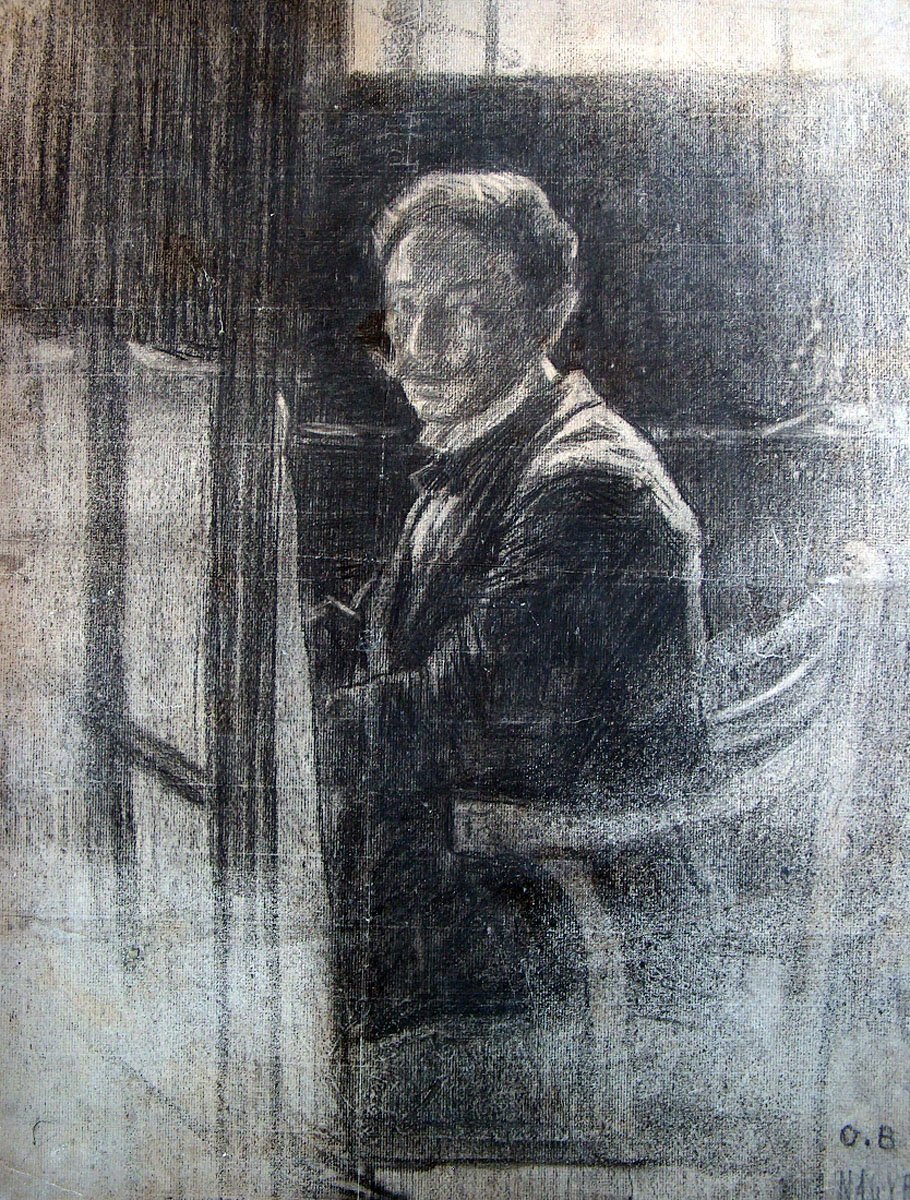
Self-portrait around 1900 (Source: mng.hu)
He made his first drawings at the age of twelve: peasants working in the fields, the surrounding landscape, flora and fauna appeared in his early works. The parents supported the boy’s painting efforts. He completed his elementary school with the Piarists of Székesfehérvár, then he graduated from grammar school in Budapest. He showed his first drawings to Antal Zichy (1823–1898), the painter's brother, who at that time was already a member of the Kisfaludy Society, a regular member of the Hungarian Academy of Sciences. He also deepened in aesthetics and literature, and continued to work according to the remarks and suggestions of the highly educated Antal Zichy.
In 1886 he enrolled in the School of Design, officially known as the National Royal Hungarian School of Design and the Teacher Training School, which was the legal predecessor of the Hungarian University of Fine Arts (MKE). The school opened in October 1871 in a house in Terézváros, then moved to 71 Andrássy Avenue in 1876, into the Neo-Renaissance villa built according to the plans of Lajos Rauscher and Ferenc Kolbenheyer, which is still the centre of the university.
 út 71., Magyar Királyi Országos Mintarajziskola (ma Magyar Képzőművészeti Egyetem). Balra az Izabella utca. A felvétel 1878 körül készült. Fortepan - Budapest Főváros Levéltára. HU.BFL.XV.jpg)
The School of Design in 1896 (Source: FSZEK Budapest Collection)
He studied at the institute for four years, from 1882 to 1886. His masters were Bertalan Székely and Károly Lotz. In 1886 he was a pupil of the historic painter, Professor Gabriel von Hackl, at the Munich Academy for half a year.
Among the wide range of Hungarian artists, from the second half of the 18th century, study trips abroad became popular. Initially, art pupils went to Vienna and then to the Munich Academy in increasing numbers from the 1860s. We consider József Rippl-Rónai to be the initiator of the “pilgrimage” to Paris, meaning that he was the painter by whom Paris became the main destination for those wishing to study the fine arts. After Rippl-Rónai, Béla Iványi-Grünwald traveled to Paris with Károly Ferenczy to the Julian Academy, founded by the painter Rodolphe Julian. One version of naturalism was the “fine naturalism” that soon spread among Hungarian painters studying in Munich around 1890, which also defined the art of Iványi-Grünwald at that time.
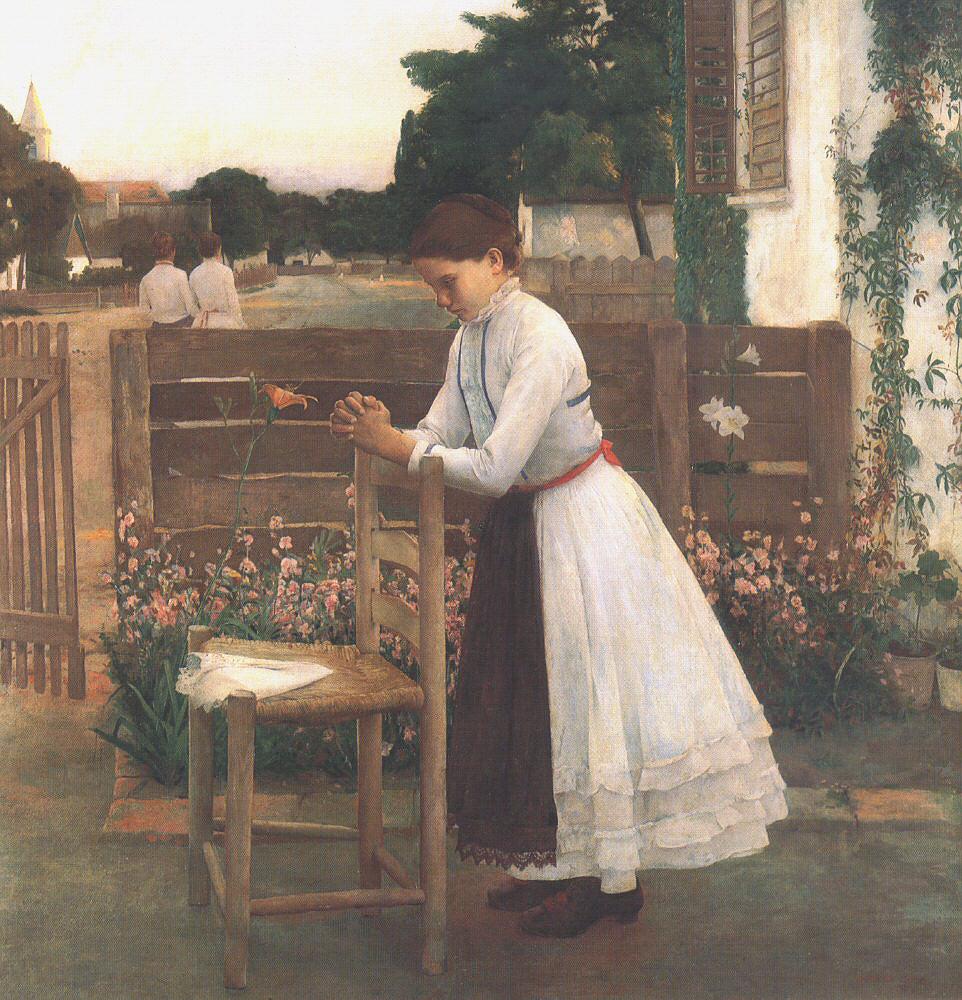
Ave Maria (Áhitat) [Devotion], 1891 (Source: mng.hu)
He graduated from Julian Academy in 1891 and went to Munich, where he joined Simon Hollósy's private school. While the Julian Academy taught “simplicity, safety,” Hollósy taught his students about “delicacies,” said painter István Réti about the two institutes.
Among Iványi-Grünwald's first major works is his painting Ave Maria (Áhitat) [Devotion], painted around 1891. He began this painting in Munich and completed it in Puszta-Viszta, part of Sopron County back then, between Újkér and Iván, which was rented by his father. From here he sent it to the Kunsthalle's winter exhibition of 1891. The painting originally featured two figures, a mother dressing her daughter preparing for church. The mother was removed from the picture by the painter, so the focus shifted to the figure of the praying girl and the prayer.
His family was less and less able to support his studies, and his debts increased. The fact that the Hungarian state bought the painting Ősszeesküvők [Conspirators] for 1,500 crowns for the National Museum was a solution to his financial problems. The payment covered his debts and allowed him to travel to Egypt for a study trip.
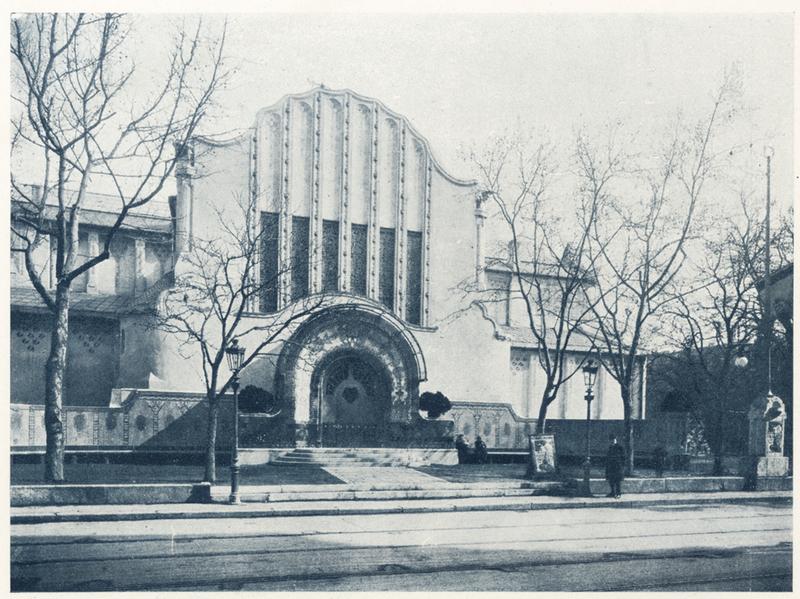
The National Salon in 1906 (Source: FSZEK Budapest Collection)
Iványi-Grünwald, who lived an active social life, took part in the founding of the National Salon on 12 March 1894. The association was formed by Hungarian artists and art supporters dissatisfied with art policy, and was established with the aim of "promoting the moral, material and cultural interests of Hungarian fine arts, the development of corporate spirit, and making the contact between artists and the public more lively."
The headquarters of the association, chaired by Jenő Zichy and György Vastagh, under the number 45 József Boulevard in the 8th District, then from 1897 it was located in the corner building at 2 Semmelweis (Újvilág) Street. From here it moved in 1906 from the Kiosk designed by Alajos Hauszmann to the building transformed by the Vágó brothers.
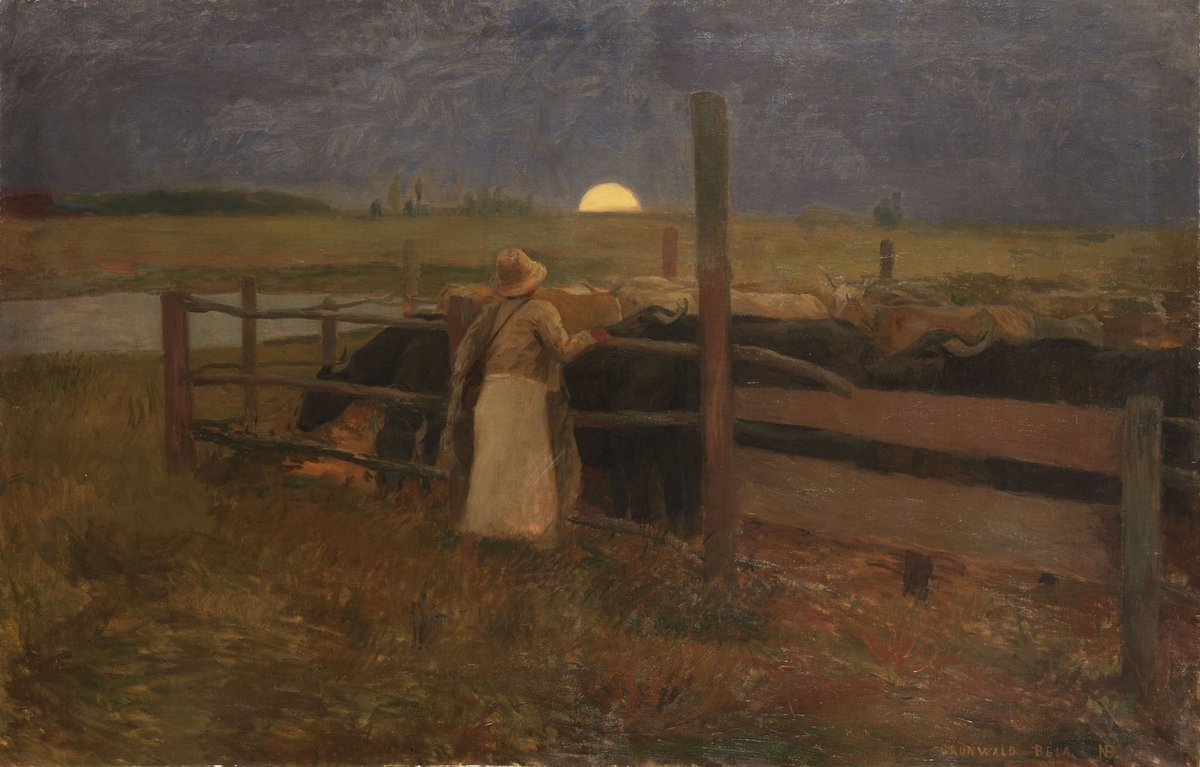
Holdfelkelte [Moonrise], 1897 (Source: mng.hu)
The painter was one of the founders of the Nagybánya Artists' Colony in 1896, along with Simon Hollósy, István Réti, János Thorma and Károly Ferenczy, István Csók, Sándor Nyilasy and Oszkár Glatz. His first work in Nagybánya [today Baia Mare in Romania] was the Holdfelkelte [Moonrise]. By the way, the artist was liked very much for his attractive personality, pleasant and elegant manners, and he had a friendly relationship with his fellow painters. Due to his helpfulness and kindness, he was also very popular among young painters.
The works of the painters working in Nagybánya were first shown in December 1897 in the Old Kunsthalle. The exhibition was not an undivided success among the general public due to the modern style of the images conveying a new pictorial conception. However, a significant number of young writers and art critics enthusiastically welcomed the exhibition. Iványi-Grünwald was featured in the exhibition with his oil paintings Est a tanyán [Evening on the Farm], Holdfelkelte [Moonrise], Fürdő fiú [Bathing Boy], Forrásnál [At a spring], Nő a vízparton [Woman on the Waterfront] and Esti hangulat [Evening Mood]. He moved his motifs from the lives of the bustling Transylvanian landscape, the lives of shepherds, miners, lumberjacks and gypsies. His paintings entitled Itatás [Watering] and Tavaszi kirándulás [Spring Excursion], which are among the most beautiful Hungarian landscapes, were painted here.
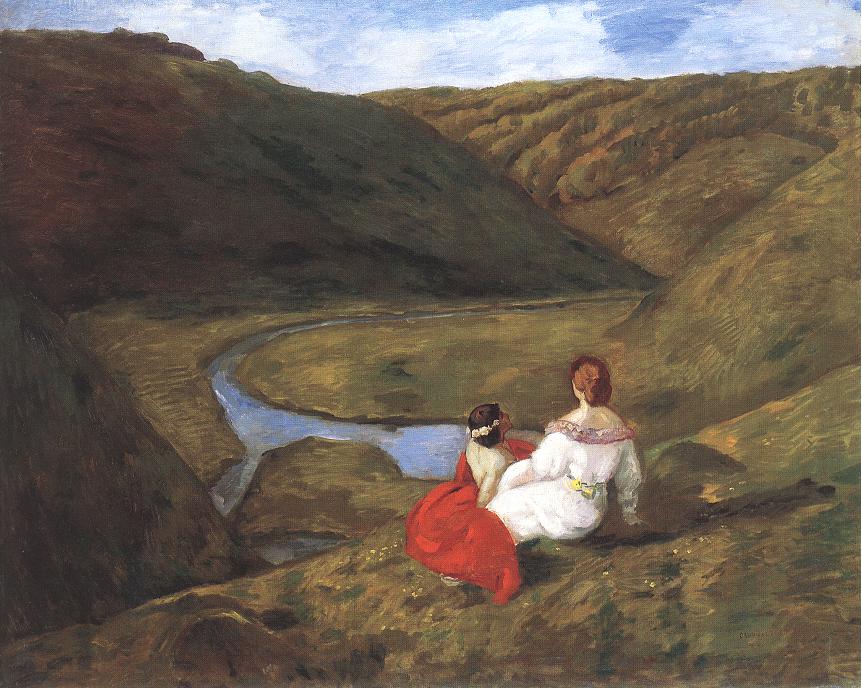
Völgyben [In the valley], around 1900 (Source: mng.hu)
Béla Iványi-Grünwald married Irén Matildo Bilcz, daughter of a Greek Catholic priest, in 1899. Their home was now set up in Nagybánya, but they spent winters in Munich. In the autumn of 1904 he was awarded a Roman scholarship founded by the honorary bishop Vilmos Fraknó. His works made in Rome now marked a complete turn in his art, which became light-hearted and confident. He returned to Nagybánya in the summer of 1905 with his wife and little son.
A solo exhibition of his paintings opened in 1906 at the National Salon. Miklós Rózsa wrote about the painter and the change in his work: "His impressionism quickly nears neo-impressionism, which is not satisfied by staying loyal to nature, but it also wants to reproduce the impression the landscape had on the artist. This art no longer works as naturalistically as Iványi's oeuvre so far, because it is strongly transposed […]. ”
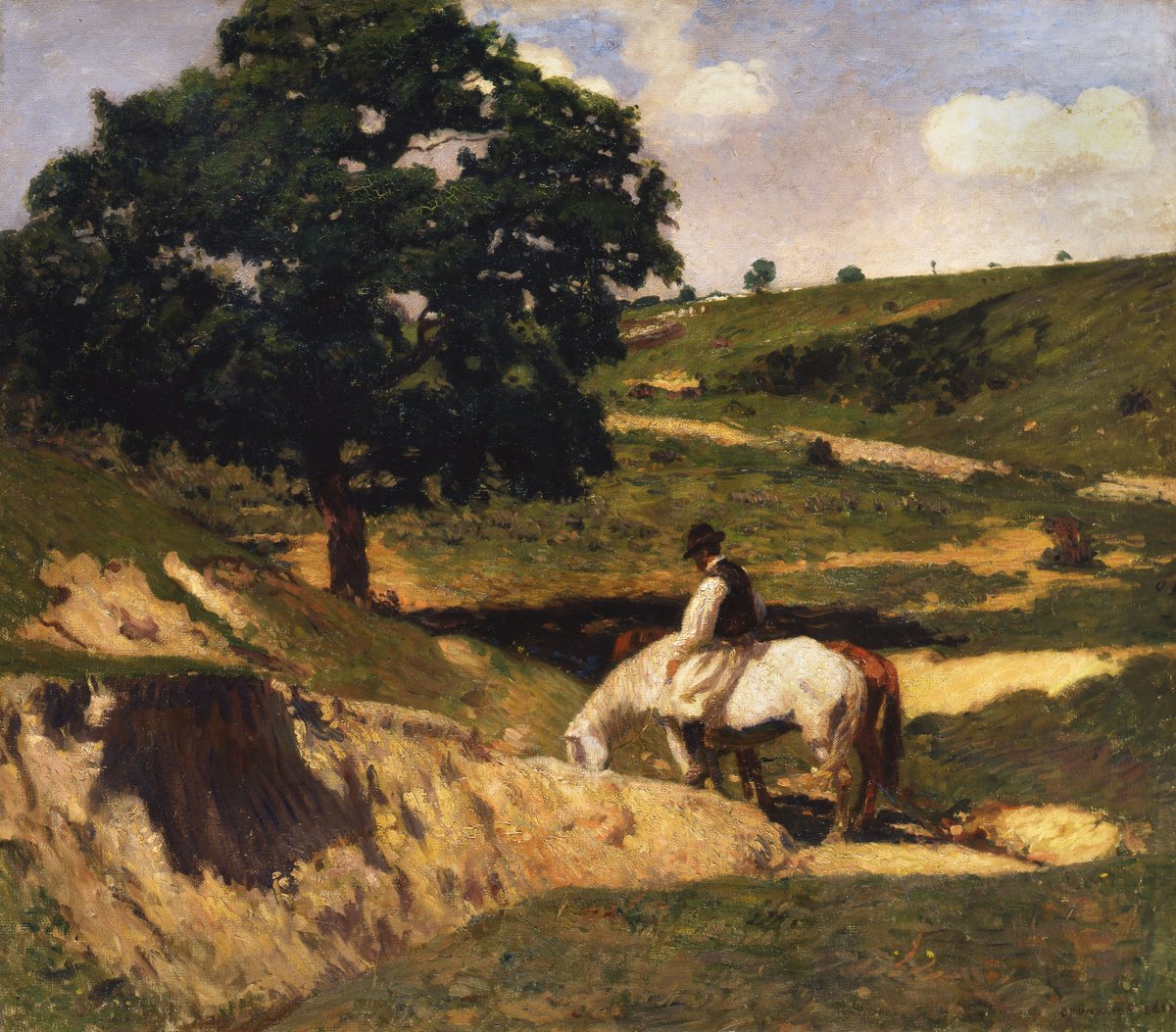
Itatás [Watering], 1902 (Source: mng.hu)
The artist used the name Iványi-Grünwald to sign his paintings from 1906, but according to the certificate of the Somogy County Archives of the Hungarian National Archives, it was officially registered on 23 October 1929. He took the name Iványi after the already mentioned settlement of Iván.
The exhibition of the works of French painters at the National Salon in May 1907 was decisive in the life of the painter receptive to new artistic phenomena, where after seeing the works of Van Gogh, Cézanne, Courbet and Gauguin he felt he has transcended the naturalistic style of Nagybánya.. He soon left both the settlement and his artistic style, which until then had defined his work.
In 1911, he established the Kecskemét Art Colony with the support of Elek Kada, the mayor of Kecskemét, who met him in Budapest. Among the works made here, Kofák a hóbuckák között [Market-Women among snow piles](1910s) stands out. This era was characterized by decorative, stylizing images. Signs of Hungarian Art Nouveau appeared in his paintings. The choice of colour and playful contour lines displayed the features of the style in Hungarian form. Lajos Kassák highlighted his vibrant colours in on of his speeches.

Kofák hóbuckák között [Market-women among snow piles], 1912 (Source: mek.oszk.hu)
In the 1920s and 1930s, he appeared in almost all major exhibitions with his work. He was one of the popular and defining figures of art life in Budapest, one of the founders and core members of the Fészek Klub. He was later remembered as the following: "Perhaps even more captivating than his oeuvre was his individuality, his delicate, soft elegance, his courtesy, his manly charm that flowed throughout his being." From 1930, he lived with their families alternately in Budapest and Balatonlelle. He mainly painted nude compositions and inserted his figures into the landscape.
His concerns due to the horrors of World War II, the departure of his son abroad (the historian dr. Béla Iványi-Grünwald went abroad in 1939 and settled in England), deteriorated his mood and state of health. He decided to visit Nagybánya for a last time, but his heart gave up. He was transported from Lake Balaton to Szent János Hospital, where he died on 24 September 1940. “With his beautiful silvery hair, slender figure, and gently smiling blue eyes, he himself was a decorative phenomenon of that rare kind of people no one was ever angry with and who brought serenity and smiles everywhere. The hospitality of his house was proverbial in the world of writers and artists” - Pesti Hírlap wrote in 1940 after his death.
His legacy exhibition was held in January 1941 at the Ernst Museum. Lajos Kassák said this about him at the opening: I stand with devotion and dedication in front of the artist's successful works. And it seems that not only me, but all of us who have gathered at this hour are sincerely enjoying and appreciating the legacy exhibition of Béla Iványi Grünwald. It is as if one were walking in a flowering garden, full of serenity and colour […]
Cover photo: Nő vízparton [Woman on the waterfront], 1897 (Source: mng.hu)

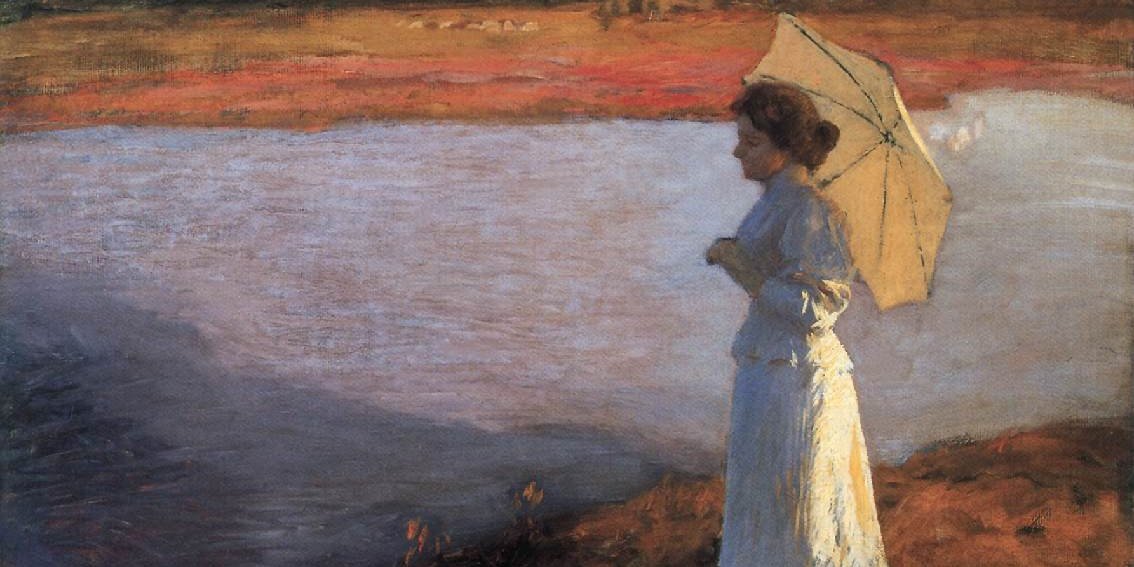
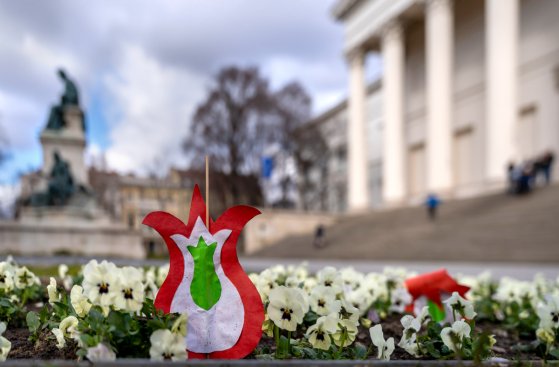

































Hozzászólások
Log in or register to comment!
Login Registration